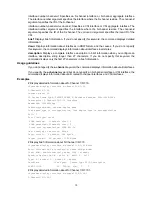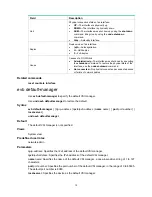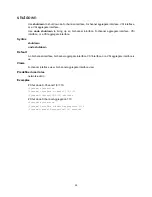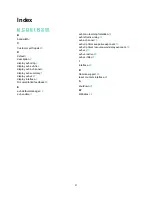
22
•
VLAN ID + MAC
•
Group ID + VLAN ID
•
Group ID + VLAN ID + MAC
When you configure VSI filters on a VSI interface, follow these guidelines:
•
Before you configure a VSI filter on a VSI interface, make sure the S-channel interface to which
the VSI interface belongs operates in trunk mode. Otherwise, the VSI filter configuration fails.
•
After you configure a VSI filter on a VSI interface, an S-channel interface automatically permits
the VLAN that is configured in the VSI filter for the subordinate VSI interface. The same rule
takes effect on Layer 2 interfaces associated with S-channels.
•
When you delete a VSI filter that contains information about a VLAN on a VSI interface, the
other VSI filters on all VSI interfaces of an S-channel interface might not contain the VLAN. If
they do not, the S-channel interface automatically denies traffic from the VLAN that is
configured on the VSI filter. The same rule takes effect on Layer 2 interfaces associated with
S-channels.
•
When a filter configured on a VSI interface contains information about a VLAN, you must not
configure the filter on the same VSI interface again or on other VSI interfaces of the S-channel
interface. If you do, an error message appears.
•
If the VSI filter is a set of VID values, and the MAC address learning function for the
corresponding S-channel is disabled, traffic for the VSI cannot be forwarded.
•
Activate a VSI interface after configuring a VSI filter, and deactivate a VSI interface before
removing a VSI filter.
When you configure VSI filters on a VSI aggregate interface, follow these guidelines:
•
Before you configure a VSI filter on a VSI aggregate interface, make sure the S-channel
aggregate interface to which the VSI aggregate interface belongs operates in trunk mode.
Otherwise, the VSI filter configuration fails.
•
After you configure a VSI filter on a VSI aggregate interface, an S-channel aggregate interface
automatically permits the VLAN that is configured in the VSI filter for the subordinate VSI
aggregate interface. The same rule takes effect on Layer 2 aggregate interfaces associated
with S-channels.
•
When you delete a VSI filter that contains information about a VLAN on a VSI aggregate
interface, the other VSI filters on all VSI aggregate interfaces of an S-channel aggregate
interface might not contain the VLAN. If they do not, the S-channel aggregate interface
automatically denies traffic from the VLAN that is configured on the VSI filter. The same rule
takes effect on Layer 2 aggregate interfaces associated with S-channels.
•
When a filter configured on a VSI aggregate interface contains information about a VLAN, you
must not configure the filter on the same VSI aggregate interface again or on other VSI
aggregate interfaces of the S-channel aggregate interface. If you do, an error message
appears.
•
Activate a VSI aggregate interface after configuring a VSI filter, and deactivate a VSI aggregate
interface before removing a VSI filter.
Examples
# Configure a VSI filter for VLAN 1 on S-Channel 1/0/1:10.1.
<Sysname> system-view
[Sysname] interface s-channel 1/0/1:10.1
[Sysname–S-Channel1/0/1:10.1] evb vsi filter vlan 1
# Configure a VSI filter for VLAN 1 on Schannel-Aggregation 1:10.1.
<Sysname> system-view
[Sysname] interface schannel-aggregation 1:10.1
[Sysname–Schannel-Aggregation1:10.1] evb vsi filter vlan 1










































